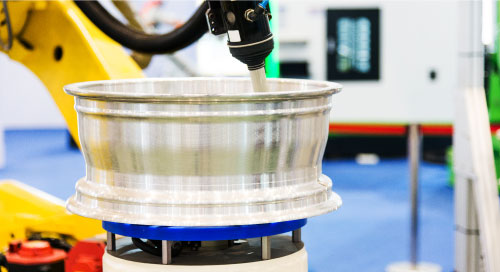AI Powers Auto Parts Factory Automation

With more than 300 million vehicles on the road, China is the world’s largest automotive market—a market that will only continue to grow thanks to the country’s booming electric vehicle sector. For auto parts manufacturers, this rapid growth presents a tremendous opportunity: a chance to carve out market share in an increasingly crowded competitive landscape.
But it’s surprisingly difficult for manufacturers to increase factory automation and production capacity. This is because they often rely on labor-intensive production processes, making it difficult to boost capacity without increasing headcount. The result is a frustrating capacity bottleneck that hampers growth and jeopardizes companies’ ability to gain competitive advantage.
Without Factory Automation, Manual Processes Don’t Scale
The manufacture of wheel hubs is a representative example of this phenomenon.
The main issue is that dynamic balancing inspection, an important quality assurance test, is specific to each wheel model. Wheel hubs from the production line must therefore be sorted before proceeding to the inspection area. But traditionally, this step in the manufacturing process is entirely manual.
Clearly, that’s not efficient. And because new wheel hub models are introduced frequently, companies are forced to retrain workers continually so that they can recognize new products.
“Manufacturers have attempted to automate wheel hub sorting and segmentation. But results have been mixed,” says Qinggaoe, Industrial Control and Vision R&D Director at Xinje Electric, a maker of AI manufacturing solutions for the automotive industry. “Solutions based on earlier machine vision applications have trouble recognizing wheels with complex structures—or differentiating between wheels with similar structures.”
But recent advances in AI and edge computing, together with next-generation processers, enable factory automation solutions that will help manufacturers operate more efficiently—reducing costs and increasing profits.
Recent advances in #AI and #EdgeComputing, together with next-gen processers, enable factory automation solutions that help #manufacturers operate more efficiently—reducing costs and increasing profits. Wuxi Xinje Electric via @insightdottech
Manufacturing Process Automation for Sorting and Segmentation
Xinje’s AI-based Wheel Hub Sorting and Segmentation solution is one example of how this works in practice.
The solution is implemented on the production line itself. Finished wheel hubs reach an initial inspection point, where an image acquisition device detects each hub and transmits the data to a nearby edge server for processing.
A computer vision application sorts the wheel hubs by type and marks them accordingly. The AI model is based on advanced deep-learning technology, which allows it to achieve a degree of accuracy far superior to older machine vision solutions. Moreover, because processing is carried out on the edge, network latency is greatly reduced, which speeds up inferencing.
Hubs are then moved down the line for segmentation—also handled by computer vision inferencing on the edge—so that they can be sent to the appropriate testing area for dynamic balancing inspection.
The solution represents a fully automated version of the traditional sorting and segmentation process. This accomplishment was facilitated Xinje’s technology partnership with Intel, Qinggaoe says. “Intel processors are very well suited to computer vision and edge computing tasks, and their software development tools are a great help when building and training AI models.”
Xinje leverages several different Intel technologies in its solution:
- 11th Gen Intel® Core™ processors offer a strong foundation for high-performance processing—especially where graphical and AI computing tasks are required.
- The built-in Intel® Gaussian Neural Accelerator 2.0 supports AI applications and offers inferencing and training support for deep-learning models.
- The Intel® OpenVINO™ Toolkit and Intel® oneAPI libraries help simplify development of computer vision applications and facilitate acceleration and optimization of AI models.
AI Factory Automation: A Case Study
Xinje’s implementation at a wheel hub manufacturer in China is a case in point. The customer was looking to increase production to meet soaring demand. But like many other manufacturers, it still relied on manual wheel sorting, creating a capacity bottleneck.
Hiring more workers wasn’t feasible—and not just because of the high cost. “Even if you have the labor budget, hiring isn’t easy in China at the moment,” explains Qinggaoe. “The manufacturing sector here is experiencing severe labor shortages that threaten productivity and profitability.”
Deploying the Xinje solution led to great results. Wheel hub classification became up to 18 times more efficient, helping the company to dramatically increase its production capacity. And the manufacturer was actually able to reduce headcount. The number of workers required to supervise the production resulted in labor cost savings of approximately 75 percent.
Best of all, there was no need to sacrifice quality for speed, because the AI model reliably achieved an accuracy rate of 99 percent.
A Smarter, Safer Future
Automating inefficient processes will help China’s auto industry meet growing demand from domestic and overseas buyers.
But the benefits of AI factory automation won’t be limited to one industry, says Qinggaoe: “There are many potential applications for AI in manufacturing. Our solution, for example, supports material classification, testing, and the manufacture of computers and consumer electronics.”
In addition to benefiting companies and consumers, AI factory automation will help workers as well. Qinggaoe says, “AI complements and extends human intelligence—and it frees workers from the need to perform repetitive and dangerous tasks in the factory.”
By improving productivity, profitability, and employee health and safety, AI will drive the digital transformation of manufacturing around the world.
This article was edited by Georganne Benesch, Associate Editorial Director for insight.tech.